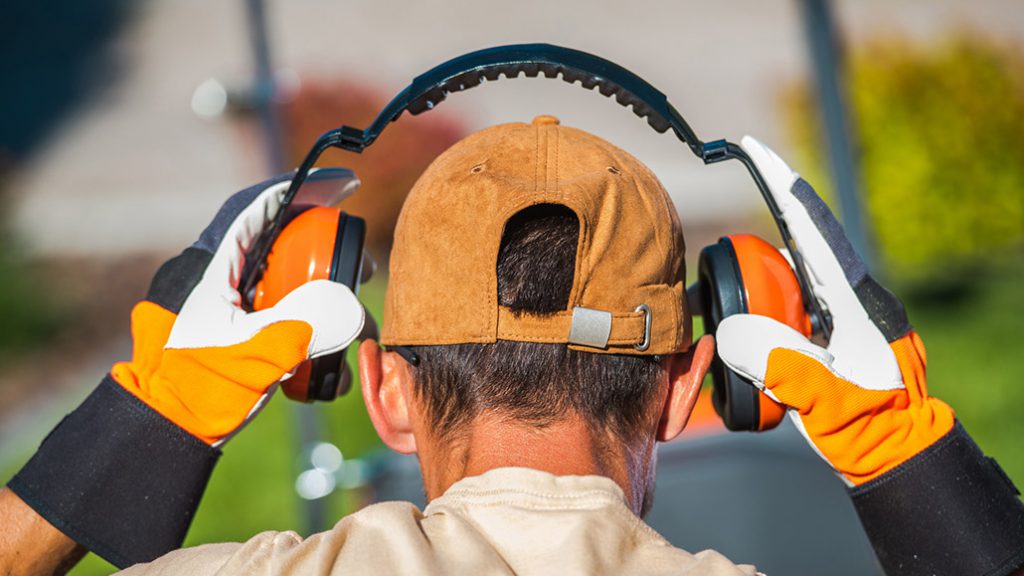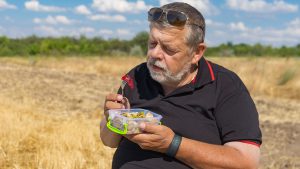Protect your hearing
UNDERSTAND OCCUPATIONAL NOISE ON THE FARM

KIDS THINK THEIR parents exercise selective hearing — that is, choosing what they want to hear, and ignoring the rest. For their part, parents think their kids do the same. But when Emery Huszka’s son challenged his dad’s hearing ability, the Bothwell-area grain farmer didn’t treat it lightly — he decided to see if there was really something to his son’s accusation. After all, Huszka was about to turn 50, and it’s estimated that by then half of all farmers have some level of noise-related hearing loss.
Fortunately, a 40-minute consultation with a trained professional at a hearing clinic showed Huszka’s hearing was in the normal range for his age. But the challenge wasn’t for nought: it gave him a baseline understanding of where he stood hearing-wise and sparked a resolve to revisit a specialist annually to track his auditory status quo.
“If things change over the years, I can get advice from a technician about other measures I should take,” he says. “I wear ear protection most of the time now, and the more we as farmers can pre-empt the damage, the better off we and our families will be. We work in noisy environments and we have to look after ourselves and our families.”
Many farmers aren’t as lucky as Huszka, says Ryan Osborn, one of three hearing instrument specialists at Beck Hearing Aid Centre in London. Osborn says farming is one of the hardest occupations on hearing. Chainsaws, augers, grain dryers, other machinery, and livestock noises commonly exceed 80 decibels, the level at which damage can occur without hearing protection.
And it’s not just a problem for ‘old-timers’.
CHECK EARLY
“As soon as a person has been involved in farming for 10-15 years they should have a hearing test,” says Osborn, who has treated farmers at clinics in Kitchener, Simcoe, and now London. “For many farmers, that could be as early as when they’re 30 years old. As part of a family farm, they’ve been exposed to occupational noise for pretty well all their lives.”
They might not even know they are affected. Auditory loss is an insidious condition that sneaks up on farmers, then often gets regarded as an inevitable occupational hazard. It starts when loud noise flattens out the inner ear’s field of sensors — commonly called “hairs” — that receive sound waves. If the noise stops, the hairs return to their upright, functional form. However, if the noise is prolonged, the hairs stay flattened – kind of like lodging in a grain field.
It’s this lodging-like effect that reduces and confuses sound uptake to the brain, particularly in the treble register where so many of the sounds that occur in conversation take place. It’s often accompanied by ringing in the ears, one of the first signs farmers will notice.
FRUSTRATION
Hearing loss has a ripple effect, impairing physical and mental health in ways that researchers are just now starting to understand. They connect stress, frustration, isolation, and even endangerment with the condition.
For example, being unable to hear a conversation is a stressful situation, and as hearing loss worsens, affected individuals become increasingly frustrated.
“Yelling so someone can hear you, instead of speaking at a normal conversation level, doesn’t promote good communication in the home,” says Osborn.
Eventually, those affected withdraw and self-isolate…a challenge in an industry that is already fraught with mental health issues.
This isolation has hearing-loss researchers worried. Connections are even being made between hearing loss and the onset of dementia — there’s enough evidence to make scientists very curious. The link has yet to be made, but as reported last fall in The Hearing Journal, common symptoms of dementia and hearing loss align, including confusion during conversation, changes in methods of communicating, difficulty completing everyday tasks, and feelings of fatigue or stress.
CHILDREN
Hearing protection strategies can’t start too early. Dr. Marsha Salzwedel, project scientist at the U.S. National Farm Medicine Center in Marshfield, Wisconsin, warns parents with infants and small children to take special note of potential problems. For example, falls and runovers aren’t the only hazards for extra riders on tractors — noise is also an issue. Salzwedel says babies and small children tend to move a lot and flail with their hands, so personal protective equipment, including earmuffs, is unlikely to stay in place. And most ear-protection muffs are designed for babies three months and older.
Salzwedel also says studies of mothers of children with poor hearing have reported environmental exposures (louder than 85 decibels in many cases). And human studies have confirmed loud environments led to shortened pregnancies and decreased birth weights.
But while hearing protection helps reduce problems, it’s ineffective if farmers don’t use it. In Nebraska and southwest Iowa, 100 farm families are involved in an onsite study by the Central States Center for Agricultural Safety and Health (CS-CASH) in Omaha, Nebraska designed to improve hearing protection use. As part of the study, boxes containing earmuffs and earplugs are attached to grain bins so farmers have the equipment at-hand when needed.
Researchers hope the convenience factor will help.
“In the safety world we talk about the hierarchy of prevention,” says the center’s community outreach specialist Ellen Duysen, “and personal protective equipment is at the bottom after all other means have been exhausted, such as engineering, administration, reduction, elimination. There are circumstances in agriculture where noise can’t be engineered out, and in these cases hearing protection is essential…but studies show it is not used by most farmers.”
PREVENTING AND ADDRESSING HEARING LOSS
A range of hearing protection devices are available, from inexpensive, disposable foam ear plugs to custom-molded ear plugs (about $160 a pair) that slide into the ear canal and filter loud sounds but still permit conversation to come through.
You can download a decibel-reading app to determine if you are in a plus-80 decibel environment or purchase a portable decibel reader.
But Robert Gobeil, agricultural health and safety specialist with the Canadian Agricultural Safety Association, says the onsite assessment doesn’t have to be so technical.
“If you’re having a conversation in a noisy environment and you notice you are raising your voice, it’s loud enough that you need hearing protection,” he says.
Not all hearing loss requires hearing aids. When it does, a host of devices are available depending on the technology and severity of the loss, from $2,000 to $6,000. Provincial programs may offset part of the cost.
The key is to get a baseline test done every three to five years. The test takes under one hour and most hearing clinics conduct them for free.


























